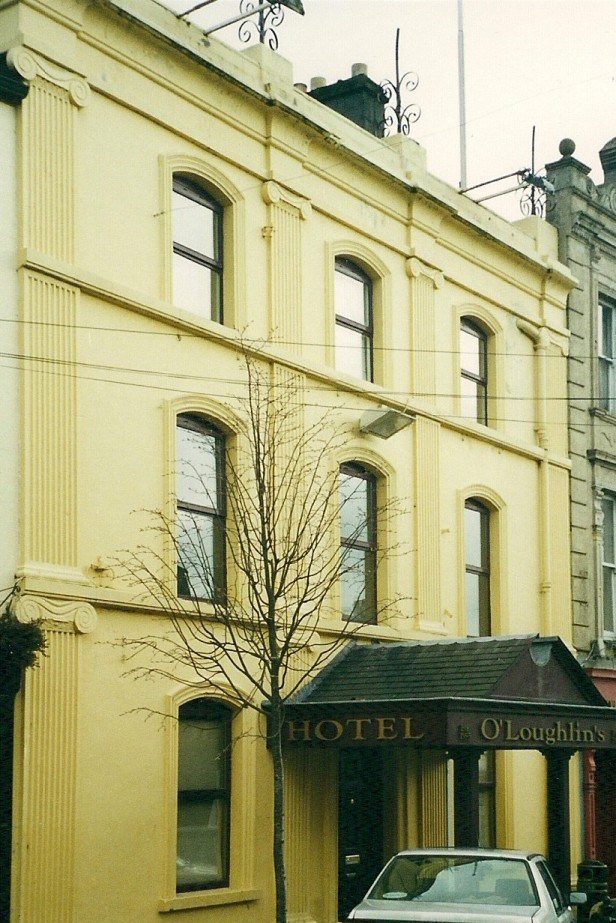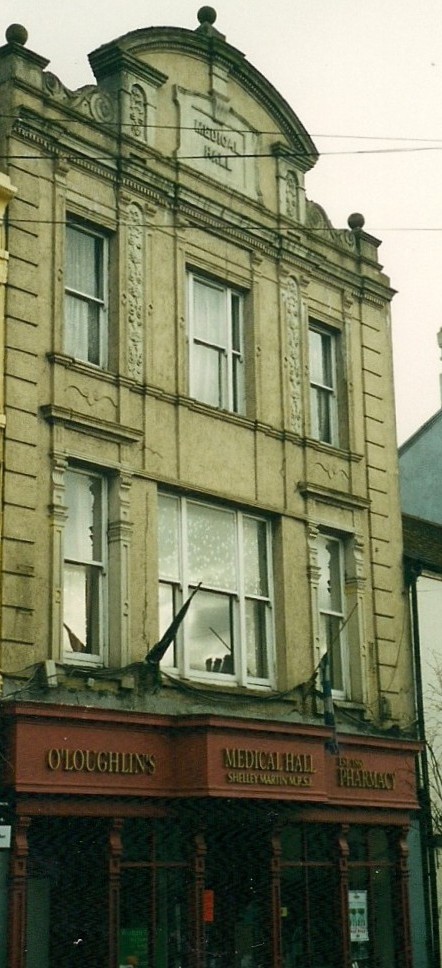

|
Characterised in the Architectual Survey as
"an integral part of
the urban fabric of the historic town core", this building, in the 1850's, was
a Police Barracks with a substantial yard
and garden. [See also note on No. 13 Market Square.] According
to the Cancellation Books, it was subsequently occupied by
Michael Whelan, a shopkeeper, followed by the Kelly family. The 1901 Census
lists Anne Kelly as a hardware merchant here, and her son Michael
as shop assistant.
In the summer of 1904, the Aird
family opened their new Central Hotel which boasted hot and cold baths
with perfect sanitary arrangements and a fine billiard room.
In 1911,
twenty-one-year-old Mary Angela Aird was manageress,
in charge of a housekeeper and five servants. Guests on Census Night
included John Wright, an English commercial traveller, and
Corkwoman, Margaret Bourke. She was an
Inspector of National Schools, one of few women,
I'd imagine, to hold such a post at that time?
On Saturday, May 15, 1915, the Leinster Express
reported that George Bernard Shaw, 'the
distinguished literateur and a party of friends who
had been on a motoring tour in the West of Ireland,
visited Maryborough on Monday evening, and
remained overnight, staying at Aird's Central Hotel'.
[GBS, incidentally, had a prior connection with Maryborough when,
during World War I, he was invited to address an
Anti-Vaccination meeting in the town. He declined, but in his
letter to the organisers,
strongly advocated "cleanliness and careful sanitation" as an
alternative to vaccination against smallpox.
In an earlier letter to the Irish Anti-Vaccination League in
May, 1911, his pronouncements were somewhat less measured: "Vaccination is nothing short of attempted murder."]
The first electric light in Ireland was a lamp outside the offices of The Freeman's Journal newspaper in Prince's Street in Dublin in 1880.
As announced in an 1919 newspaper advertisement, Aird's
was lighted by electricity and has an installation
of electric bells. They had an oil-driven generator in the yard behind the hotel and their Maryboro Electricity
Works was one of more than 150 separate 'mini' electricity systems in the country at the time. Some were run by local
authorities, others by entrepeneurs like J.J. Aird. The surplus electricity not used in their own premises
was sold to other businesses in the town. In 1929, the giant hydroelectric plant at Ardnacrusha was commissioned
and the Electricity Supply Board eventually bought out all the small companies throughout the country. From the early
1930’s, electricity was available to anyone who wanted it in Portlaoise town. Maryborough Asylum, incidentally, already had
electric lighting since 1898.
The Aird family was also involved in the
motor car trade and, in the 1920's, their Central Garage was situated at the rere of
the hotel. Open night and day, the Garage sold Clyno cars - at the time, the third largest car
manufacturer in the UK after Austin and Morris - but warned: Cars driven at
owners' risk.
In 1933, Dan Breen, Fianna Fáil TD and author of My Fight for Irish Freedom, a memoir
of his time in the IRA, was having a drink in Aird's when he was approached by a local man.
Words were exchanged, a blow was struck and, to cut a long story short, the encounter continued
out on Main Street where more fisticuffs ensued, a gun was produced but not fired,
and the local man - a relation of my own - ended up in hospital.
Aird's Hotel continued until the late 1960's,
after which it had a variety of owners and
names. In the 1970's and '80's, it was Henderson's
(with its nightclubs,
The 21 Club and Scamps,) and, in the early 90's, The Regency. The latter
had Kenos, Portlaoise's Only Real Nightclub
(which, in November 1990, was ordered by
the District Court to turn down the volume).
Since the late 1990's, Club 23 (later truncated to 'Club') has been the place to shake a leg/bust a few moves. Or whatever the current term is!
For a short while in 1997, incidentally, the hotel featured an incongruous thatched porch on Main Street.
In 'O'Loughlin's time', there used to be a display case in the hotel with a
a set of Prescription Books from Bolger's Medical Hall. (See below).
They made for fascinating reading:
the medically-minded among you wous have pored over the details of obsolete cures,
while someone like myself found find great interest in the names
of all the townspeople long gone. But one thing that did catch my non-scientific eye was
how often glyco-heroin was prescribed for the nuns in the Presentation Convent. Let me quickly add that heroin,
mixed with glycerin (and, often, sugar or spices) to make it more palatable, was widely
used not only as a painkiller, but as a remedy for coughs, asthma, and pneumonia.
P.S. In February 1905, Maryborough Workmen's Club, situated in Railway Street adjoining
the rere of the Hotel, was completely gutted by fire. All the club's property, including a billiard
and two bagatelle tables, was destroyed.
In 2020, its new owners rebranded O'Loughlins as the Town Hotel
The Medical Hall has also been described as making "a very strong positive contribution to the architectural landscape of Portlaoise." It dates from the early 20th century, before which time there were two premises on this site. In the 1850's, the one on your left was occupied by William Murphy and subsequently Joseph Finn. In the 1880's, Thomas Lalor had his public house here set to a Mrs Catherine Fagin who, in the next decade, was succeeded by Patrick A. Meehan. More about the Meehan family later. The second house was occupied successively by John Murphy, a bootmaker and leather seller, John McCormack, John Fitzpatrick, Charles Quinn and William Callanan. The last-named was a draper and tailor. In a local newspaper of January 7, 1899, Mr James B. Bolger, 'formerly Senior Compounder in Graham's Chemist, Westmoreland Street, Dublin', announced the opening of his new Medical Hall. In 1901, he was living here with his brother John, a clerk, and his mother Marianne. She was a Queen's County native but her sons were both born in County Carlow. Also on the premises on Census Night were two teenagers; Patrick McCabe a "pharmaceutical apprentice" and the inevitable servant, Elizabeth Meehan, both from County Kildare. The business was clearly prospering because, in 1902, Mr Bolger announced the opening of a 'branch house' in Mountmellick. [As can be clearly seen in a photograph from the early years of the 20th century, the Medical Hall was once topped by a large pyramidal conservatory. It was a prominent and, to my non-professional eye, entirely harmonious addition to the streetscape, though architects among you may have a different view. I have no idea what it was used for - Growing herbs for medicinal compounds? Hothouse flowers? Sunbathing? - nor when or why it was removed.] By the time of the 1911 Census, James Bolger was married to Mary Elizabeth (née Meehan) and had three young children, Mary Elizabeth, Norah Teresa and Patrick Michael. His brother John was still part of the household which now included John Mackle, an assistant from Derry, and two local girls; Mary Robinson, a general domestic and Annie Phelan, a nurse. In due course, Patrick Bolger became a dentist and his younger brother John, a solicitor. Bolger's Medical Hall flourished for many years (1956: See our windows. Stockists of Chanel, Yardley, Coty, Max Factor and Ponds) and was eventually succeeded by John Kennedy's Pharmacy (1960) and, since the 1990's, O'Loughlin's. The hotel and pharmacy are both owned by Declan O'Loughlin who is well-known in GAA circles and was a selector with the Laois Senior Footballers during the Mick O'Dwyer era (2003-2006) when the county won its first Leinster Senior title since 1946. In November 2016, O'Loughlin's Pharmacy closed for good and the business - now known as Chemco - set up shop in Lyster Square. In 2017 the self-explanatory NK Nails & Beauty opened here. In 1851, both of these premises were leased from Mrs Sophia J. Stoker. She was more than likely related to the Stoker family from Ballyroan, one of whom, Bartholomew, was once a highly-regarded portrait painter. He died in 1788 aged only 25 and is interred with his parents in old St Peter's Churchyard in Railway Street. More recent members of the family lie in St. Peter's in the Market Square. So, what's the connection between 'our' Mrs Stoker and the creator of Dracula? There's a bit of research to get your teeth into. |
 |
 |
| HOMEPAGE |